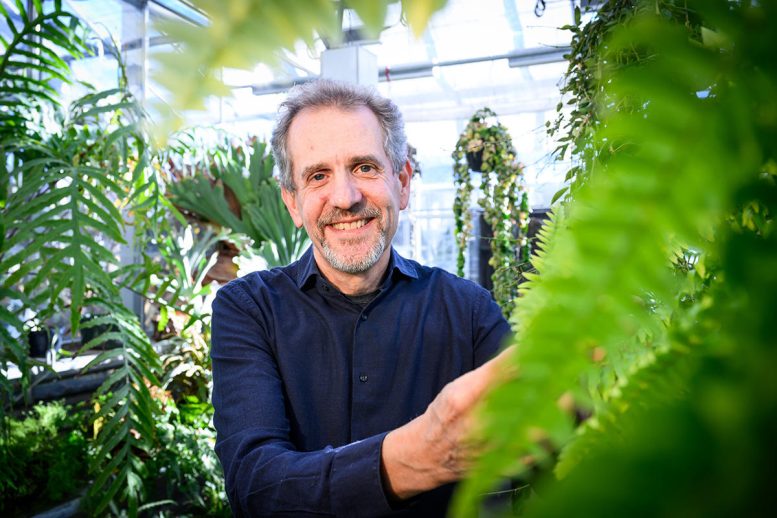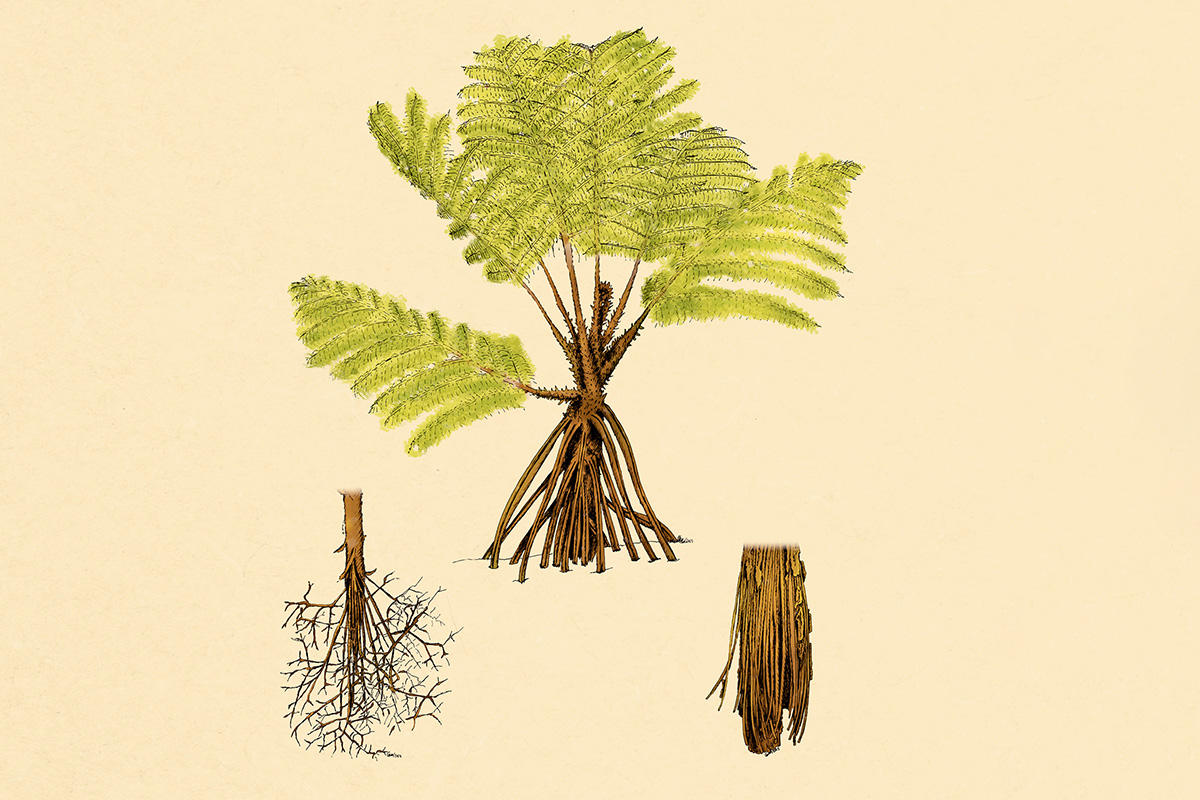Other plants, including some ferns, send out leaves or shoots that touch the ground and sprout roots to sustain a new plant. But the Panamanian tree fern, Cyathea rojasiana, reconfigures its “zombie leaves,” reversing the flow of water to draw nutrients back into the plant. Credit: Graphic by Camila Pizano, color by Michael Vincent
Plant biologists have discovered that a unique species of tree fern, exclusive to Panama, has the ability to regenerate its deceased leaf fronds into root-like structures. This fern, known as Cyathea rojasiana, transforms these “zombie leaves” by altering their water flow direction, enabling them to absorb nutrients back into the main plant.
This weird phenomenon occurs only after the leaves die and droop to the ground, said University of Illinois Urbana-Champaign plant biology professor James Dalling, who made the discovery with his team while studying a different plant in a Panamanian forest reserve. Dalling noticed that the fronds were strongly embedded in the soil and had sprouted a network of rootlets. Laboratory tests revealed that the zombie leaves were drawing nitrogen out of the soil.
Even after they are converted into roots, the wilted fronds look like decayed plant matter, which is probably why generations of plant biologists failed to notice that they were performing a life-sustaining task, Dalling said.
“This is a truly novel repurposing of tissue. And it’s distinct from what we know other ferns do,” he said.
The Uniqueness of Cyathea rojasiana
Other plants, including some ferns, send out leaves or shoots that touch the ground and sprout roots to sustain a new plant, he said. But reconfiguring dead tissue to feed the original plant has never been reported. The new findings are detailed in the journal Ecology.
C. rojasiana belongs to an ancient lineage of tree ferns dating back to the Jurassic period, Dalling said. The zombie leaves are most likely an adaptation to the nutrient-poor volcanic soils.
Geological and Environmental Context
“Panama is a land bridge between North and South America that coalesced 7 million years ago out of an archipelago of islands, and those islands are the result of volcanic activity in the past,” he said. “In one site we discovered, a layer of volcanic ash several meters deep looks like sand that you would dig up on a sandy beach. The plants that grow there are distinct from those that we find elsewhere in that forest reserve.”

University of Illinois Urbana-Champaign plant biology professor James Dalling and his colleagues discovered that some tree ferns recycle their dead fronds into roots. The researchers call these repurposed fronds “zombie leaves.” Credit: Fred Zwicky
The patchiness of the vegetation means soil nutrients also are unevenly distributed.
“And so the tree ferns seem to be putting out tentacles to sample the surrounding soils,” Dalling said. “They’re able to sample a greater range of nutrient environments for the same amount of investment of rootlets than if they just sent out a single rooting structure all around the fern. I think it’s all about the economics of how they use resources in a patchy environment.”
The tree ferns also grow very slowly.
“They’re probably putting on one or two leaves a year, and so they’re adding on the order of a few centimeters of height a year,” Dalling said.
This means each frond is a major investment of resources that the plant repurposes after the leaf dies. The slow growth also means that the tree fern is short enough that when its fronds die, they droop all the way to the ground. The trees reach a maximum height of about two meters, Dalling said.
The finding is “another example of the extraordinary diversity of plant adaptations that exist in resource-poor environments,” he said.
Reference: “Zombie leaves: Novel repurposing of senescent fronds in the tree fern Cyathea rojasiana in a tropical montane forest” by James W. Dalling, Evidelio Garcia, Carlos Espinosa, Camila Pizano, Astrid Ferrer and Jéssica Lira Viana, 18 January 2024, Ecology.
DOI: 10.1002/ecy.4248
Dalling also is a research associate at the Smithsonian Tropical Research Institute in Panama.

Dr. Thomas Hughes is a UK-based scientist and science communicator who makes complex topics accessible to readers. His articles explore breakthroughs in various scientific disciplines, from space exploration to cutting-edge research.







